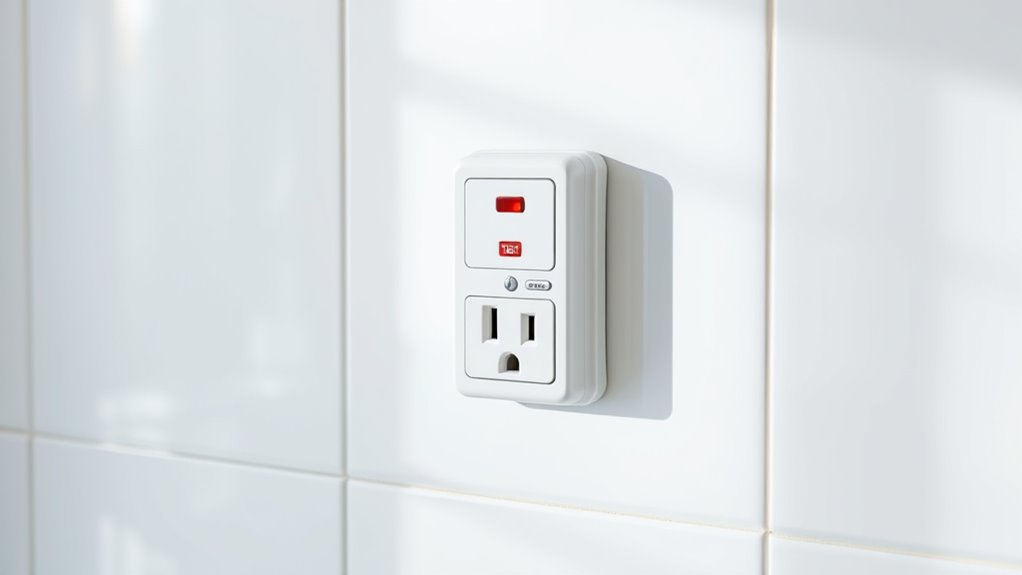Ground Fault Circuit Interrupters (GFCIs) save lives by detecting tiny electrical leaks that could cause shocks. They constantly monitor the current in hot and neutral wires, instantly shutting off power if they sense an imbalance as small as 4-5 milliamps. This quick response prevents dangerous shocks, especially in wet areas like kitchens and bathrooms. To understand how these safety devices protect you and your loved ones, keep exploring what makes GFCIs so effective.
Key Takeaways
- GFCIs detect small current leaks to the ground and shut off power within milliseconds, preventing electric shocks.
- They are especially vital in moist environments like bathrooms and outdoor areas where water contact increases shock risk.
- By quickly disconnecting electricity during ground faults, GFCIs protect individuals from severe injuries and fatalities.
- Regular testing and proper maintenance ensure GFCIs function correctly, maintaining their lifesaving capabilities.
- Installing GFCIs in high-risk areas reduces electrical fires and enhances overall safety in homes and public spaces.
Understanding the Basics of GFCIs

Ground Fault Circuit Interrupters, or GFCIs, are safety devices designed to protect you from electrical shocks by monitoring the flow of electricity in a circuit. They constantly compare the current entering and leaving, looking for discrepancies that could signal a leak. If the GFCI detects even a small imbalance—typically as low as 4 or 5 milliamps—it quickly shuts off power to prevent harm. This rapid response helps reduce the risk of severe shocks, especially in areas with water exposure like kitchens and bathrooms. GFCIs are installed in outlets or circuit breakers and serve as a first line of defense against electrical accidents. Understanding how they operate gives you confidence in their role in keeping your home safe.
How GFCIs Detect Imbalance in Electrical Current
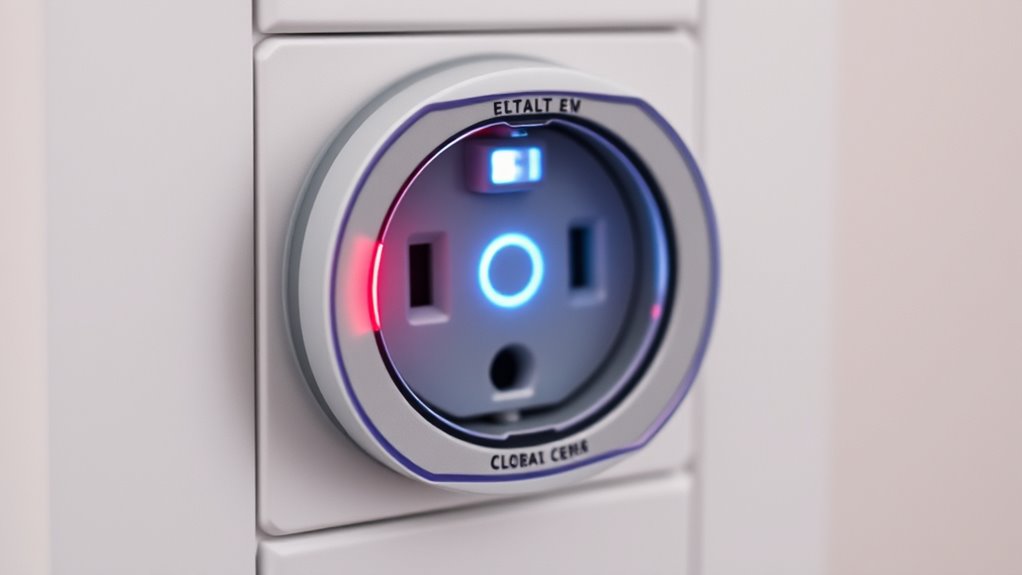
GFCIs detect imbalance by constantly monitoring the electrical current flowing through the circuit. They compare the current entering the device with the current returning through the neutral wire. If there’s any difference, it indicates electricity might be leaking somewhere, possibly through a person. This process is similar to AI in Business applications that analyze data patterns to improve outcomes. Here’s how they do it:
GFCIs monitor current flow to detect leaks and prevent shocks quickly.
- They use a sensor called a differential current transformer that surrounds the hot and neutral wires.
- When the currents are equal, the magnetic fields cancel each other out.
- If there’s an imbalance, the sensor detects it immediately and triggers the circuit to shut off.
This rapid detection allows GFCIs to respond within milliseconds, preventing harmful shocks and reducing the risk of electrical fires. Their ability to sense tiny differences is key to protecting you effectively.
The Mechanism Behind GFCI Operation
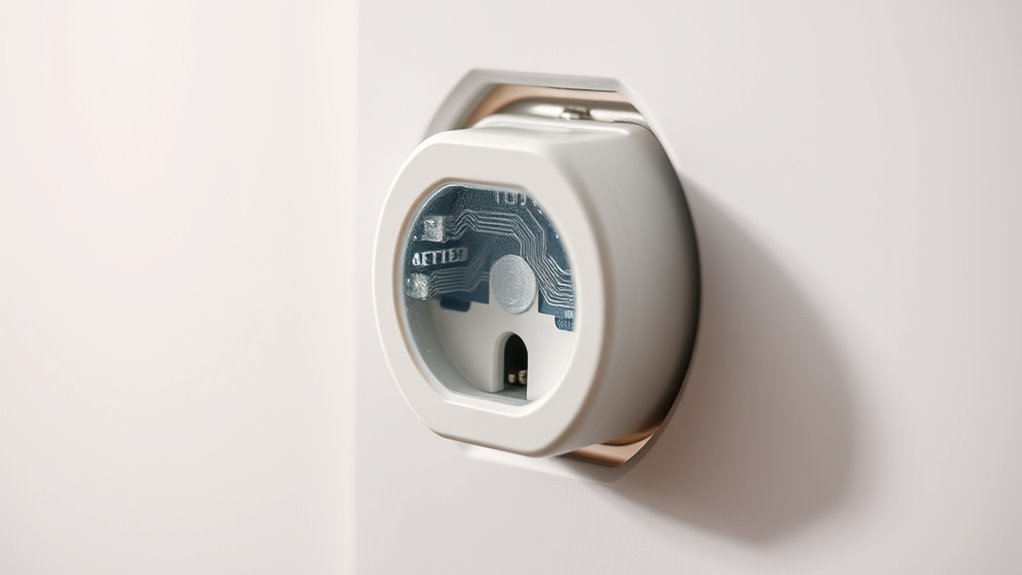
You can understand how GFCIs work by looking at how they detect imbalance currents. When the device notices even a small difference, it responds quickly to cut off power. This rapid trip response helps keep you safe from electrical shocks. Additionally, understanding AI security vulnerabilities can inform improvements in safety devices like GFCIs to enhance their reliability.
Detecting Imbalance Currents
How do GFCIs quickly detect dangerous electrical imbalances? They constantly monitor the current flowing through the hot and neutral wires. If there’s a difference, even as small as 4 milliamps, the GFCI recognizes this imbalance as a potential ground fault. When this happens, it immediately triggers the internal mechanism to cut off power, preventing harm. The device uses a differential transformer to compare the current. If the currents don’t match, the GFCI acts fast. Regular testing ensures the device’s proper functioning and maintains safety. This precise detection is what makes GFCIs essential for safety in everyday electrical use.
Rapid Trip Response
When a ground fault is detected, the GFCI’s internal mechanism responds almost instantaneously to prevent harm. It swiftly disconnects power, often in less than a fraction of a second, stopping electrical current from flowing where it shouldn’t. This rapid trip response is crucial in protecting you from electric shock and fire hazards. The GFCI constantly monitors the current balance between the hot and neutral wires. When it senses an imbalance, it triggers the trip mechanism immediately, cutting off power. Imagine the relief of knowing your home is safeguarded in an emergency. Here’s a visual for you:
| Fault Detection | Trip Activation | Power Disconnection |
|---|---|---|
| Sudden imbalance | Trip relay engages | Circuit breaker trips |
| Immediate response | Stops current flow | Protects lives |
| Fast action saves lives | Prevents injuries | Ensures safety |
Additionally, the effectiveness of a GFCI depends on proper installation and maintenance to ensure its reliable operation over time.
Common Situations Where GFCIs Are Essential

Because electrical shocks are more likely to occur in moist environments, GFCIs are vital in areas where water and electricity may come into contact. You should install GFCIs in places like bathrooms, kitchens, and laundry rooms to protect yourself from potential shocks. These devices quickly cut off power when a ground fault is detected, preventing injury or electrocution. GFCIs are also essential outdoors, such as on decks, patios,, and near pools, where exposure to water increases risk. Remember, any outlet near water sources should have a GFCI for safety. By ensuring GFCIs are in these common areas, you considerably reduce the chance of shock incidents, keeping yourself and your loved ones safe from harm. Additionally, understanding trust issues within relationships underscores the importance of safety and communication in all aspects of life.
The Difference Between GFCIs and Ground Faults

Understanding the difference between GFCIs and ground faults helps you recognize how these safety devices operate. GFCIs detect imbalances in electrical current, while ground faults are specific issues where electricity leaks to the ground. Knowing these distinctions keeps you safer and ensures proper use of circuit protection.
GFCI Functionality Basics
Ground Fault Circuit Interrupters (GFCIs) are designed to protect you by quickly shutting off power when they detect uneven current flow, but many people confuse them with ground faults. GFCIs monitor the current leaving and returning through a circuit. If they notice even a tiny difference—like 4-6 milliamps—they trip instantly to prevent shock or electrocution. It’s not the same as a ground fault, which is an unintended path for current, often caused by damaged wiring or moisture. GFCIs don’t eliminate ground faults; they simply detect the imbalance and interrupt the circuit. This rapid response minimizes your risk of electrocution and electrical fires.
- They compare the hot and neutral currents in real-time.
- A small imbalance triggers an immediate shutoff.
- GFCIs work within milliseconds for maximum safety.
Ground Fault Characteristics
While GFCIs detect small current imbalances to prevent shocks, a ground fault refers to an unintended path for electricity, often caused by damaged wiring or moisture. Ground faults occur when current escapes its normal circuit, potentially traveling through a person or unintended object. This can happen in wet or damaged outlets, appliances with broken insulation, or exposed wiring. Unlike GFCIs, which are protective devices, a ground fault is a condition that can lead to electrical shocks or fires if not addressed. GFCIs sense these faults quickly and shut off power, but understanding the difference helps you recognize hazards. Ground faults are dangerous because they bypass safety measures, increasing the risk of injury or damage. Proper detection and correction are essential for electrical safety, especially in environments where moisture or damage increase the likelihood of faults like outdoor camping sites.
Installing and Testing GFCIs Safely
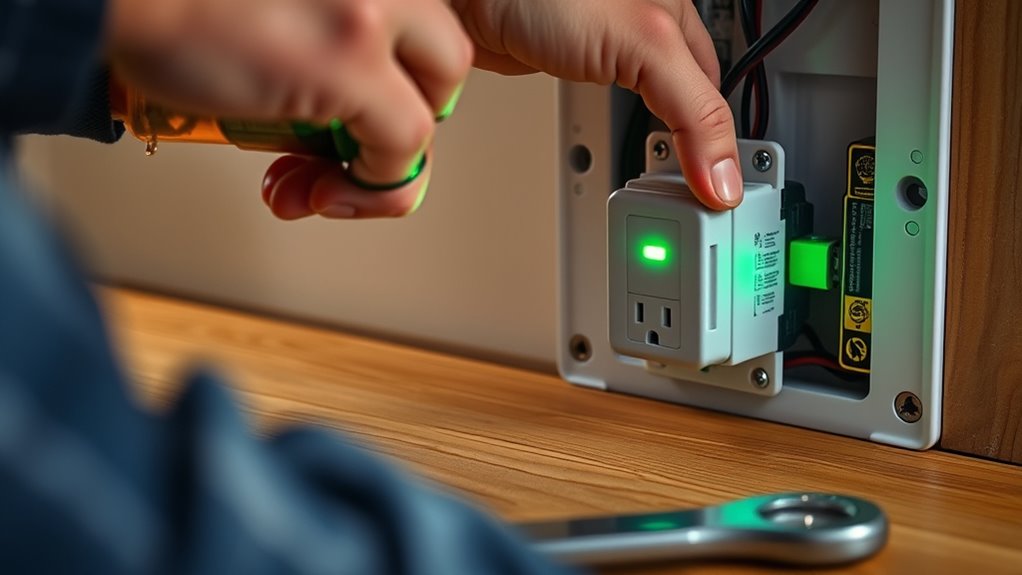
Installing and testing GFCIs safely is crucial to guarantee they provide proper protection without risking electrical hazards. First, turn off the power at the breaker before beginning installation. Follow the manufacturer’s instructions carefully, ensuring the GFCI is wired correctly with hot, neutral, and ground connections secure. After installation, test the GFCI immediately using the built-in test button to confirm it trips properly. Regular testing is essential—press the test button monthly to ensure it functions correctly, and reset it afterward. Proper voiceover technique during testing can help you identify potential issues early. Always turn off power before working on the circuit. Use a voltage tester to confirm power is off. Test the GFCI regularly to maintain safety.
Recognizing When a GFCI Needs Replacement
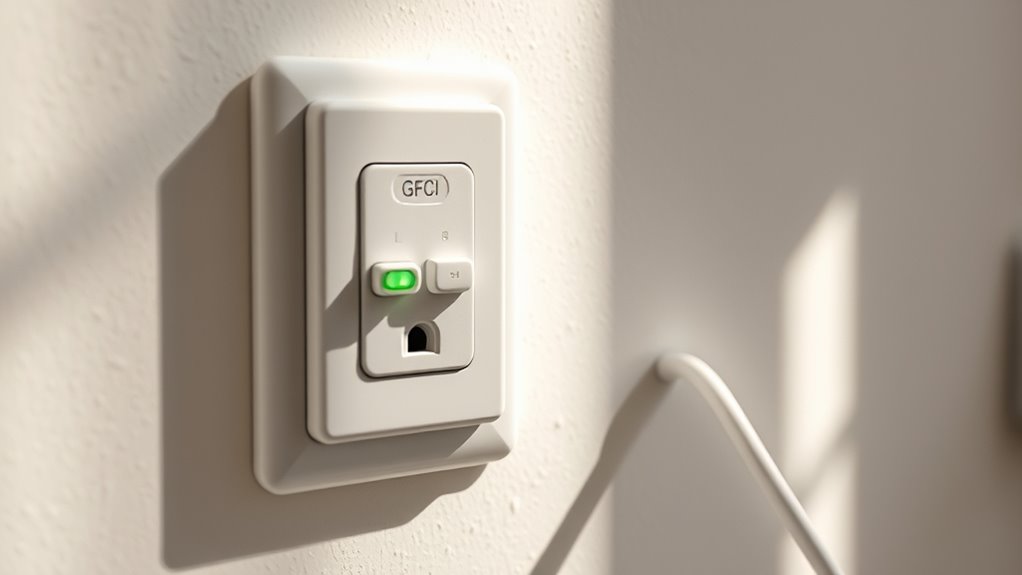
Ever wonder if your GFCI is still working properly? One sign it might need replacement is if it trips repeatedly without cause. If pressing the reset button doesn’t restore power or it won’t reset at all, it’s a clear indicator of failure. Also, check for physical damage, such as cracks or burn marks, which suggest internal issues. If your GFCI feels warm or hot to the touch, replace it immediately—heat can signal malfunction. Additionally, if testing with the built-in button fails to trip the device, it’s no longer reliable. It’s essential to trust your GFCI’s function; when in doubt, replace it to ensure your safety. Regular testing and inspection help you catch problems early, preventing potential electrical hazards. Incorporating remote work safety tips into your routine can further enhance your home environment.
The Role of GFCIs in Residential and Commercial Safety
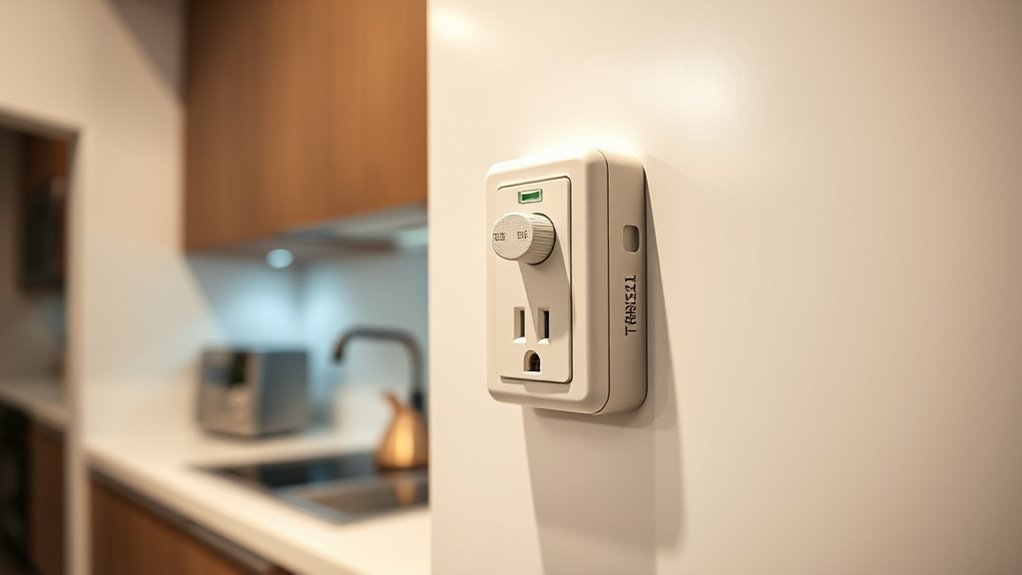
GFCIs play a vital role in keeping you safe by preventing electric shocks in homes and businesses. They also help protect your property from damage and guarantee you meet safety standards. By installing GFCIs, you not only enhance safety but also stay compliant with electrical codes. Understanding the impact of public health initiatives can further emphasize the importance of safety measures like GFCIs in maintaining overall well-being.
Preventing Electric Shocks
Have you ever wondered how to protect yourself from dangerous electric shocks in your home or workplace? GFCIs are essential tools that help prevent shocks by shutting off power quickly when they detect a ground fault. They monitor current flow and respond in milliseconds to imbalances, reducing the risk of injury. To maximize safety, consider these tips:
- Install GFCIs in areas prone to moisture, like kitchens and bathrooms
- Regularly test GFCIs to ensure they’re functioning correctly
- Avoid using damaged cords or outlets that can cause faults
- Attention is crucial in maintaining safe and effective creative practices, just as it is in electrical safety.
Protecting Property and People
Did you know that ground fault circuit interrupters play a essential role in safeguarding both your property and the people around you? GFCIs help prevent electrical fires caused by ground faults, which can damage wiring and structures. They also protect appliances from surges that could lead to costly repairs. By quickly shutting off power when a fault is detected, GFCIs reduce the risk of fires and electrical damage, keeping your home or business safe. Additionally, they minimize the chances of severe shocks that could harm someone nearby, especially in wet or damp areas. Installing GFCIs in kitchens, bathrooms, garages, and outdoor outlets ensures that both your property and everyone present are protected from electrical hazards. They are a fundamental safety feature for any residential or commercial space.
Code Compliance Benefits
Ensuring your property meets electrical safety standards is essential for legal compliance and peace of mind. Installing GFCIs helps you adhere to electrical codes required in residential and commercial spaces. These devices demonstrate your commitment to safety, reducing liability and avoiding penalties during inspections. GFCIs also guarantee that your property stays up-to-date with evolving regulations, making future upgrades smoother.
- Meets national electrical code requirements for safety
- Simplifies inspection and certification processes
- Protects against potential fines and legal issues
Benefits of Regular Maintenance and Inspection
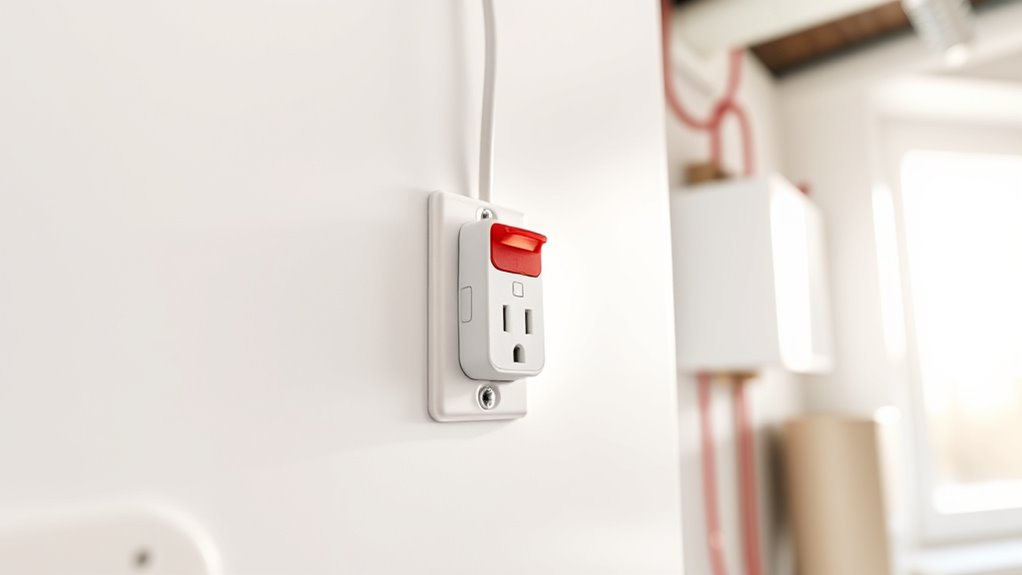
Regular maintenance and inspection of ground fault circuit interrupters (GFCIs) can substantially enhance their reliability and safety. By routinely checking your GFCIs, you ensure they respond correctly during a fault, reducing the risk of electrical shock or fire. Regular testing, such as pressing the test and reset buttons, confirms the device functions properly. Inspecting for signs of damage, corrosion, or loose connections helps prevent potential failures. Keeping your GFCIs clean and free of debris also maintains their sensitivity. Proper maintenance not only extends the lifespan of the device but also guarantees that it will operate effectively when needed most. Ultimately, consistent inspections give you peace of mind, knowing your electrical system is protected and your loved ones are safer.
Future Developments in Ground Fault Protection Technology
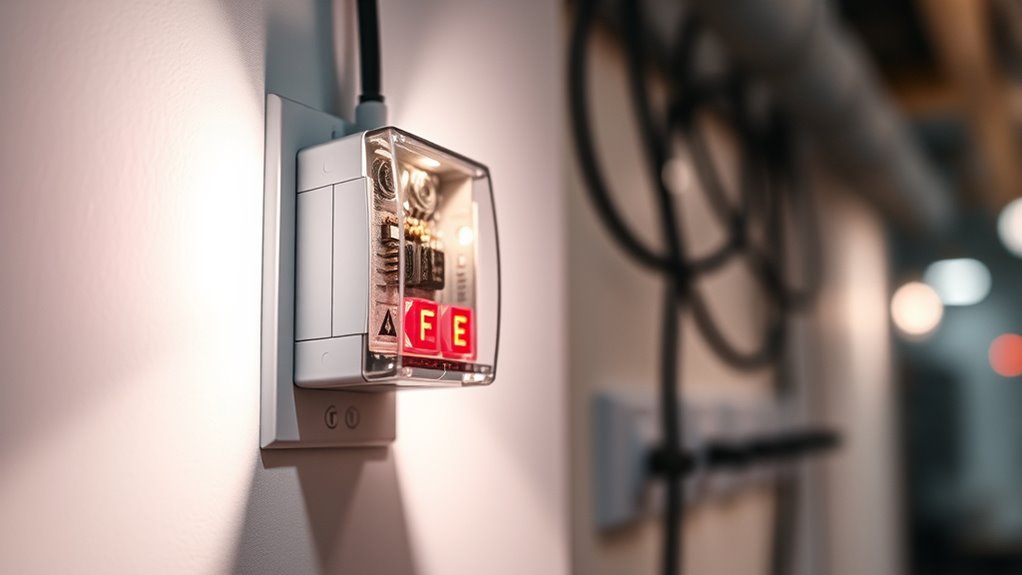
Advancements in ground fault protection technology are poised to make electrical safety devices more responsive and reliable than ever before. Future innovations will focus on faster detection times, reducing the risk of injury or damage. Smart sensors will continuously monitor electrical systems, providing real-time data and predictive maintenance alerts. Integration with home automation will enable GFCIs to communicate with other devices, enhancing overall safety. Additionally, improved calibration methods will assure devices stay accurate over time, minimizing false trips. These developments aim to make ground fault protection more intuitive, minimizing hazards and maximizing protection. With ongoing research and technological progress, you can expect safer, smarter electrical systems that better prevent shock and fire risks in your environment.
Frequently Asked Questions
Can GFCIS Prevent All Types of Electrical Shocks?
You might wonder if GFCIs prevent all electrical shocks. While they’re highly effective at stopping many shocks caused by ground faults, they don’t protect against every type of electrical shock. GFCIs quickly cut power when they detect imbalances, but they can’t prevent shocks from direct contact with live wires or faulty equipment. To stay safe, always follow proper electrical safety practices, even if you have GFCIs installed.
Are GFCIS Required in Outdoor Electrical Outlets?
Imagine this: it’s the 21st century, and safety isn’t optional. You need GFCIs in outdoor outlets because they protect you from electrical shocks caused by moisture or ground faults. Building codes often require GFCIs outdoors, especially in areas exposed to weather or water. So, yes, it’s not just a good idea but a legal requirement in many places. Protect yourself and follow local electrical codes.
How Often Should GFCIS Be Tested for Safety?
You should test your GFCI outlets at least once a month to make certain they’re working properly. To test, press the “test” button; if the outlet trips and cuts off power, it’s functioning correctly. Then, press the “reset” button to restore power. Regular testing helps prevent electric shocks and fires, keeping you and your family safe. Always follow the manufacturer’s instructions for testing and maintenance.
Do GFCIS Work During Power Outages?
Imagine a safety net that only works when you’re mid-air—that’s what GFCIs do, but only when power’s on. During outages, they don’t function because they rely on electricity to detect faults. So, if you’re cooking or using outdoor outlets during a blackout, know that GFCIs won’t protect you unless power’s restored. Always turn off devices and test GFCIs before reusing outlets after outages.
Are GFCIS Effective Against Electrical Fires?
You might wonder if GFCIs can prevent electrical fires. While they’re excellent at stopping shocks by cutting off power when detecting ground faults, they aren’t specifically designed to prevent fires. However, by detecting small leaks of current, GFCIs can sometimes catch issues that could lead to fires, offering an extra layer of safety. Still, regular inspections and proper wiring are essential to fully prevent electrical fires.
Conclusion
By installing and maintaining GFCIs, you’re creating a safe haven where sparks of danger are swiftly cut off, much like a vigilant guardian watching over your home. Imagine the peace of mind knowing that when a sudden imbalance sparks, your GFCI acts instantly—saving lives and preventing disasters. Stay proactive, keep these protectors in top shape, and turn your space into a fortress where safety flows as freely as electricity itself.
